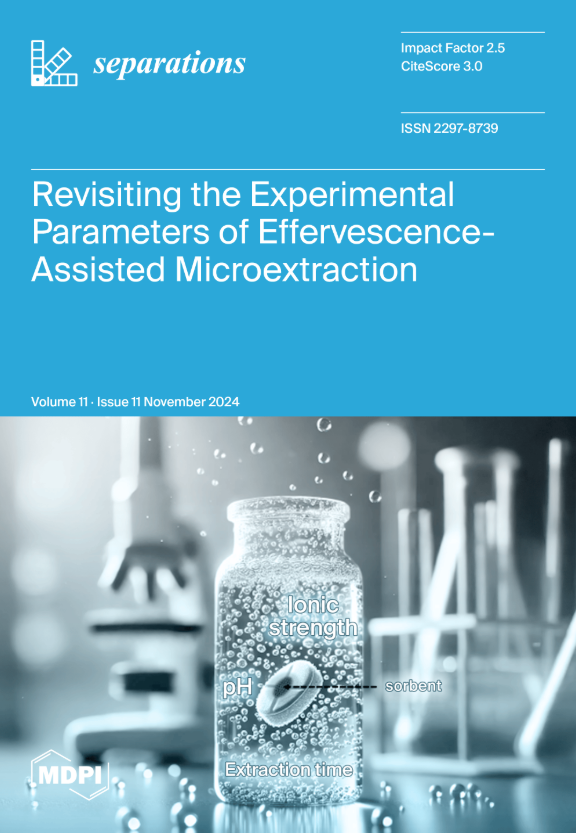Advancements in Adsorption Techniques for Sustainable Water Purification: A Focus on Lead Removal
IF 2.7
4区 工程技术
Q3 CHEMISTRY, ANALYTICAL
引用次数: 0
Abstract
The long-term sustainability of the global water supply, with a paramount emphasis on cleanliness and safety, stands as a formidable challenge in our modern era. In response to this pressing issue, adsorption techniques have emerged as pivotal and widely recognized solutions for the removal of hazardous pollutants, with a particular emphasis on lead adsorption from wastewater. This comprehensive review explores the relentless advancements made in the adsorption domain, highlighting innovations using separation and purification techniques that surpass traditional metal oxide-based adsorbents. Of particular note is the growing exploration of alternative materials, such as starch, chitosan, nanoscale structures like zeolites and metal-organic frameworks, magnetic materials, and carbon-based substances for the development of inorganic adsorbents. These materials, with their remarkable capacity for nanoscale structural adjustment, possess extraordinary capabilities for effective contaminant removal, facilitating swift water purification. The literature survey for this review was conducted using the Google Scholar engine, with “adsorbents for lead remediation” as the starting keywords, resulting in approximately 6000 papers. The search was refined to focus on the last three years and specifically targeted review papers which are most relevant to lead remediation. More than 100 papers were analysed to investigate various techniques, surface modifications, and adsorbent materials for managing inorganic pollutants in water. This review also illuminates research limitations, with a specific focus on starch-based adsorbents in lead remediation. As we progress towards practical commercial applications, this review identifies challenges associated with the development of inorganic adsorbents and provides invaluable insights into future prospects. Surface modification emerges as a promising path, with the potential to substantially enhance adsorption capacity, potentially doubling or even quadrupling it. Moreover, the adsorbents demonstrate impressive regenerative capabilities, maintaining up to 90% regeneration efficiency after multiple cycles. In conclusion, starch-based adsorbents show considerable potential as effective agents for lead purification from aquatic environments. Nevertheless, the need for further research persists, emphasizing the optimization of the adsorption process and exploring the long-term stability of starch-based adsorbents in real-world scenarios.可持续水净化的吸附技术进展:以铅的去除为重点
全球供水的长期可持续性,以清洁和安全为首要重点,是我们当今时代面临的一项艰巨挑战。为了应对这一紧迫的问题,吸附技术已经成为去除有害污染物的关键和广泛认可的解决方案,特别强调从废水中吸附铅。这篇全面的综述探讨了在吸附领域取得的不懈进步,突出了使用分离和净化技术的创新,超越了传统的金属氧化物基吸附剂。特别值得注意的是,人们正在不断探索替代材料,如淀粉、壳聚糖、纳米级结构,如沸石和金属有机框架、磁性材料和碳基物质,以开发无机吸附剂。这些材料具有非凡的纳米级结构调整能力,具有有效去除污染物的非凡能力,促进水的快速净化。本综述的文献调查使用Google Scholar引擎进行,以“用于铅修复的吸附剂”作为起始关键词,大约有6000篇论文。搜索经过改进,将重点放在最近三年,并专门针对与铅修复最相关的综述论文。对100多篇论文进行了分析,研究了管理水中无机污染物的各种技术、表面改性和吸附材料。这篇综述也阐明了研究的局限性,特别关注淀粉基吸附剂在铅修复中的应用。随着我们在实际商业应用方面的进展,本综述确定了与无机吸附剂发展相关的挑战,并为未来前景提供了宝贵的见解。表面改性是一种很有前途的途径,具有显著提高吸附能力的潜力,可能使其增加一倍甚至四倍。此外,吸附剂表现出令人印象深刻的再生能力,在多次循环后保持高达90%的再生效率。总之,淀粉基吸附剂作为水生环境中铅的有效净化剂具有相当大的潜力。然而,需要进一步的研究,强调吸附过程的优化,探索淀粉基吸附剂在现实场景下的长期稳定性。
本文章由计算机程序翻译,如有差异,请以英文原文为准。
求助全文
约1分钟内获得全文
求助全文
来源期刊

Separations
Chemistry-Analytical Chemistry
CiteScore
3.00
自引率
15.40%
发文量
342
审稿时长
12 weeks
期刊介绍:
Separations (formerly Chromatography, ISSN 2227-9075, CODEN: CHROBV) provides an advanced forum for separation and purification science and technology in all areas of chemical, biological and physical science. It publishes reviews, regular research papers and communications. Our aim is to encourage scientists to publish their experimental and theoretical results in as much detail as possible. There is no restriction on the length of the papers. The full experimental details must be provided so that the results can be reproduced. There are, in addition, unique features of this journal:
Manuscripts regarding research proposals and research ideas will be particularly welcomed.
Electronic files and software regarding the full details of the calculation and experimental procedure, if unable to be published in a normal way, can be deposited as supplementary material.
Manuscripts concerning summaries and surveys on research cooperation and projects (that are funded by national governments) to give information for a broad field of users.
The scope of the journal includes but is not limited to:
Theory and methodology (theory of separation methods, sample preparation, instrumental and column developments, new separation methodologies, etc.)
Equipment and techniques, novel hyphenated analytical solutions (significantly extended by their combination with spectroscopic methods and in particular, mass spectrometry)
Novel analysis approaches and applications to solve analytical challenges which utilize chromatographic separations as a key step in the overall solution
Computational modelling of separations for the purpose of fundamental understanding and/or chromatographic optimization
 求助内容:
求助内容: 应助结果提醒方式:
应助结果提醒方式:


